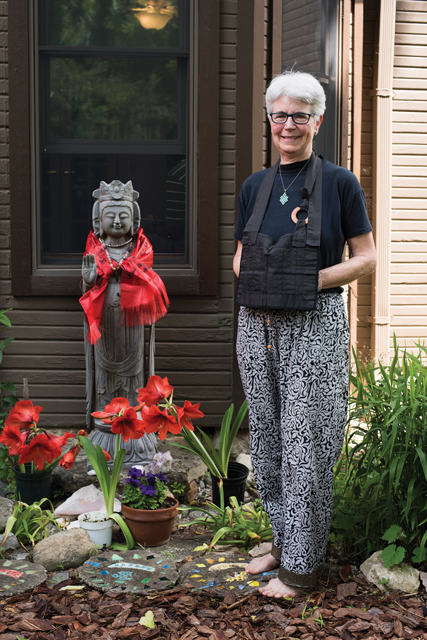City: Yellow Springs, Ohio
Tradition: Vipassana, Zen, and Vajrayana
Year Founded: 1993
Number of Members: 100
Meeting Place: Center-owned residential home
Tricycle talks with Katie Egart, Buddhist chaplain and Yellow Springs Dharma Center trustee:
The Yellow Springs Dharma Center offers teachings and practice instruction in Vipassana, Zen, and Vajrayana. How was this multi-sectarian approach adopted, and why is it important to the Center?
The Center was established by people who practiced in those different traditions and wanted one place where everybody could sit. Because we’re in a very small town in rural Ohio—Yellow Springs has less than 4,000 people—it made sense to have one place that people could come to.
We don’t all share the same teacher in one school, and our teachers live elsewhere, so we’ve had to adopt a very strong board—of seven to ten members usually, with representatives from all three traditions—to decide on what teachers to bring in, what retreats to hold, and so on. Our commitment is to keep the integrity of each tradition. This isn’t a mishmash; there are three distinct paths. But we talk to each other, plan together, and operate the Center together.
Related: Buddhist to Buddhist
How do you help newcomers explore Buddhism’s various schools?
When people come in, they’re usually trying to develop a meditation practice, so we suggest they make use of the Center’s daily sittings at 7:00 a.m. and p.m. These are very simple: come in, take a seat, and maintain silence for 40 minutes. We give instruction in basic meditation (following the breath) and a brief review of the three traditions at two orientation sessions each month. After that we encourage them to come Saturday mornings for zazen [Zen meditation], Sunday mornings for Vipassana, or special days for Vajrayana practice.

Should the students eventually commit themselves to a particular practice?
We don’t put that view out there. Teachers will often talk about that, but [commitment to] a particular teacher or path is not so much our goal for new students as the discovery of the dharma in general. If somebody starts practicing Zen, they don’t need to align themselves with our teacher; they can have their own. What we’re concerned about is that the teachers that we bring in are authentic.
How has the Center chosen its teachers, and who are they?
After Rebecca Bradshaw from Insight Meditation Society led the Vipassana retreat for a couple of years, the group felt she should be our designated teacher. The same thing happened in Zen with Daniel Terragno Roshi [a teacher in the Diamond Sangha tradition and dharma heir of John Tarrant Roshi]—we invited him for a couple of retreats and wanted to designate him as our teacher—so those nominations went before the board and were approved. We have lots of other visiting teachers who are also decided by the board. Chokyi Nyima Rinpoche, the founder of Rangjung Yeshe Institute in Nepal, is one of our guiding teachers, but we also offer Dzogchen practices from Chogyal Namkhai Norbu; Dzogchen teachings are linked to the Nyingma school of Tibetan Buddhism.
What’s it like to run a dharma center in rural Ohio?
Yellow Springs is the home of Antioch College and a very progressive town full of artists, healers, and ecologically-minded folks. We’ve been really blessed to be fully supported in town, where diversity in all ways is a strong community value. When we did a major capital campaign to buy our building, many community members who were not part of the Center provided generous donations. Ohio doesn’t have many Buddhist organizations, especially compared to the coasts, so people come with more curiosity than expertise, you could say.
Related: Meet a Sangha: Columbus Karma Thegsum Chöling
Are there times throughout the year when the whole sangha comes together? If so, what’s that like? Is it ever awkward? I can recall many meet-and-greet tea events at dharma centers that were quiet enough to hear a pin drop.
Every year we observe Vesak, the holiday marking the Buddha’s birth, enlightenment, and death. Our celebration includes rituals and chants from each of the three traditions, ending with an all sangha potluck. Since Yellow Springs is a small town, we have many connections to each other in the larger community, so no, it is not awkward. But it can be interesting to discuss the teachings of each tradition as it comes up in the book discussions we run. That helps us not get attached to our individual views!